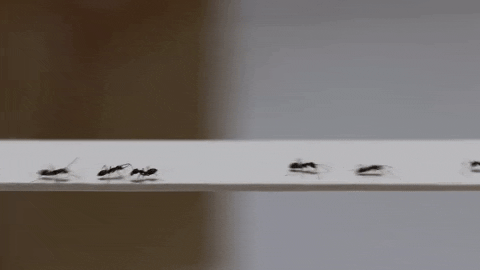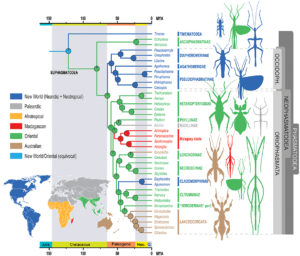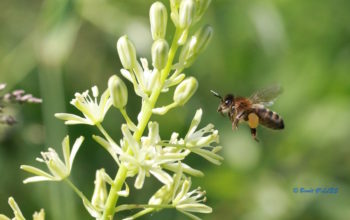An interesting discovery about the mutual relations between the leaf-cutting ants (“mushroomists”) and the mushrooms they cultivate has just been published in the journal Nature. Research conducted by Danish entomologist Henrik Hjavard De Fine Licht and his team demonstrate through comparative analyses of genetic and molecular expressions that ants depend on fungi to synthesize certain essential enzymes and amino acids, a capacity lost by insects during evolution. The fungus, in addition to being a source of nutrients, is therefore an essential molecular synthesis pathway for ants. Thus, ants and fungi behave as a single organism, connected by an important network of interactions, where each plays specific roles as organs in an organism.
Some species have established in the course of evolution relationships with mutual benefits (food, protection, reproduction…) mutualism. Mushroom ants and the fungus they cultivate have co-adapted morphologically, physiologically and behaviourally to the point of becoming totally dependent on each other. Their interdependence is such that today, the survival of one cannot be achieved without the presence of the other: this type of mutualism is called symbiotic. Ants feed on the fungus (a Basidiomycete of the genus Leucoagaricus) which grows on a substrate of plant material brought by ants (read also this article). The fungus, sexually isolated, depends entirely on the insect for its reproduction: it is an endosymbiosis (as opposed to ectosymbiosis where the two organisms are independent for their reproduction).
caption id=”attachment_1566″ align=”alignright” width=”234″] Illustration of Gongylidia and Staphylae of Basidiomycete (Source : De Fine Licht, 2014)[/caption]
Illustration of Gongylidia and Staphylae of Basidiomycete (Source : De Fine Licht, 2014)[/caption]
The evolutionary history of this mutualism goes back about 50 million years. 20-25 million years ago, the emergence in the fungus of organs rich in carbohydrates, lipids and enzymes gongylidae, grouped in bouquets (staphylae), satisfying all the nutritional needs of ants, increased the dependence of insects on the fungus for their food ( see illustration opposite). This major innovation also coincides with the sexual isolation of the fungus, which has become dependent on ants for its reproduction and multiplication. These two events led the two ancestral species to become totally interdependent, and then diversify into 4 genera: Trachymyrmex, Sericomyrmex, Acromyrmex and Atta ( see illustration below).
caption id=”attachment_1583″ align=”alignleft” width=”245″] Phylogenetic reconstruction of the co-evolution between fungus and fungal ants (Source : De Fine Licht, 2014)[/caption]
Phylogenetic reconstruction of the co-evolution between fungus and fungal ants (Source : De Fine Licht, 2014)[/caption]
This co-adaptation represents a unique opportunity and constitutes a very good study model to understand the molecular mechanisms involved in the implementation of such a high degree of dependence.
That’s why De Fine Licht and his teams are learning more about gongylidae. By analyzing gene expression and the synthesis of enzymes and amino acids in gongylidae and ants, scientists have made several discoveries.
They first noticed that enzymes synthesized in gongylidae were found, not degraded, in ants’ faeces then dispersed on areas of the substrate little colonized by the fungus. It appears that these enzymes play a role in the degradation and detoxification of plant matter thus promoting the growth of fungal mycelium. The fungus thus increases its development and multiplication thanks to ants. The synthesis of these elements by the fungus represents a significant energy cost and metabolic investment, but gives it a real advantage.
They then showed that ants had lost, during evolution, the ability to synthesize certain enzymes and amino acids essential to their survival such as phenylalanine, essential for sclerotization of the cuticle. This amino acid is strongly expressed in the gongylidae of the fungus and is then ingested by ants. The loss of this synthesis route has made ants totally dependent on the fungus as a food source, especially since they do not have sufficient enzymes to degrade and assimilate plant matter.
Ants thus benefit from a nutrient supply that meets their needs via the fungus, and the fungus from an effective means of dispersal and multiplication.
The emergence of all these morphological, physiological and molecular events has led to the isolation of a fungus line and the total dependence between these two ancestral species. For 20-25 million years, the co-adaptation and co-evolution of these species has allowed a better exploitation of resources with an increase in the size of colonies (several million individuals), the emergence of polymorphic worker castes (majors, media and minority) linked to the division of tasks (lire th article).
The current colonies of mushroom ants probably exploit 100 000 times more plant material than the first colonies.
A recent discovery shows that this fungus can be parasitized by another fungus of the genus Escovopsis… A story to read here.
Source :
– H. H. From Fine Licht; J. J. Boomsma & A. Tunlid (2014) : Symbiotic adaptations in the fungal cultivar of leaf-cutting ants. Nature Communications, 5 : 5675 (lien)
Recommendation of works on this theme :
– Les Ants: Behavior, Social Organization and Evolution (Luc Passera – Edition : Canadian Science Publishing – 480 pages – January 2005)
– The world of ants (Remy Chauvin – Edition : Editions du Rocher – 2 October 2003)
– The extraordinary world of ants (Luc Passera – Edition : Fayard – 235 pages – March 13, 2008)
– Ant Ecology (Lori Lach, Catherine Parr & Kristi Abbott – Edition : OUP Oxford – 424 pages – 10 juin 2010)
– The Leafcutter Ants – Civilization by Instinct (Bert Holldobler & Edward O. Wilson – Edition : Norton & Compagny – 192 pages – 26 octobre 2010)






